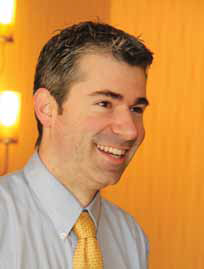Profile: Richard Culatta

Richard Culatta, Director, Office of Educational Technology, U.S. Department of Education
One of Richard Culatta’s biggest sources of passion is getting schools connected. T&L Managing Editor Christine Weiser sat down with Culatta at the Summit to discuss some of his goals for Edtech.
TL: Tell me about the ConnectED program.
RC: ConnectED is the initiative that President Obama announced that aims to connect 99% of schools to broadband within five years. There are three pieces to this initiative.
First is making sure there’s actual broadband, and we define that as at least 100 kbps per student in the classroom. The connection doesn’t help the school if it’s just to the front office. You want the connection in the hands of students and teachers. That’s what we mean by connecting schools.
The second piece is that you have to have the devices. You’re not connecting if you don’t have devices. We want students to be creators, to be empowered by using these tools, to have access to great resources like the Learning Registry (learningregistry.org), and to have access to experts and expertise that they wouldn’t have otherwise. So if they don’t have devices, that’s very hard to do.
The third piece is to make sure that there’s professional development for teachers so they are empowered to leverage their creativity and their experience. And all of this is sort of super-charged by technology—to create better learning experiences that extend beyond the school day and the classroom.
Tools and ideas to transform education. Sign up below.
Connecting schools is incredibly empowering for parents. When students and teachers have access, parents have many more ways to stay engaged and to participate in the school day.
ConnectEd is an opportunity to not just digitize the current model, but to provide this new capability as a lever to reimagine learning. This is a solvable problem if enough people weigh in to say they believe this is an important problem to solve.
TL: What can school districts do to help make that happen?
RC: Recently the FCC released a notice of proposed changes to modernize their eRate program—which funds connectivity in schools across the country. School districts need to be involved in providing feedback and suggestions for how this program can be updated to provide faster connections to schools. We also need to help people understand what the problem is. So doing things like taking the school speed test (schoolspeedtest.org) is hugely important. And we should not forget that, in addition to connecting to broadband, districts also need to help teachers prepare to leverage connected learning environments and get great digital learning materials in the hands of students.
TL: Any tips on educating parents about the connectivity issue?
RC: It’s up to school leaders to reach out to their parent communities with this message. Let them know what’s going on and why bandwidth is important. There is a great nonprofit site called the educationsuperhighway.org that has a lot of good information schools can share with parents. Parents need to understand that there is still a huge broadband gap in some places and if the cost of broadband goes down, that frees up funding to do other things. Parents shouldn’t expect their kids to go to a school that doesn’t provide an infrastructure that is essential for preparing them to work in the 21st century.
TL: Can you talk a little bit about how districts can manage all of the data that comes out of these connections?
RC: There’s probably more data in education than any other space. But we don’t take advantage of most of it. We need to find ways to make sure that data is helping students and parents and teachers make better educational decisions.
MyData is another initiative that we are doing at the Department of Education. The MyData Initiative seeks for every student (or parent of an underage student) to have access to his or her own academic data in a secure digital format. This initiative requires the participation of schools and software developers to create the ability for students to download their own data to create a personal learning profile that they can keep with them throughout their learning career. This would also require the use of common data standards so information downloaded from one tool or service can be consumed by another and vice versa. We are working with vendors to get this done.
The other point is that, while there is an enormous amount of data, it’s mostly based on testing. How do you measure more of a project-based learning experience or create something more like a digital portfolio? If you have connected devices with rich media, you can get all kinds of great data that can create a learning positioning system. It can create a path for the learner—where they’re going and what they could do next.
TL: Last August, the DOE hosted their first Connected Educator Month (connectededucators.org) . This year, the event will be held throughout the month of October. Can you tell us about the plans for this year’s event?
RC: Last year, nearly 100,000 hours of professional development were completed virtually through Connected Educator Month. I hope this year we have significantly more. Last year, most teachers were doing this event on their own. This year, we really hope schools step up and make time for their teachers to participate together.
Only a small handful of the events during Connected Educator Month are hosted by the Department of Education. Our main goal is to provide a shared calendar and invite experts from around the world to host virtual events for teachers to connect and share with each other.
